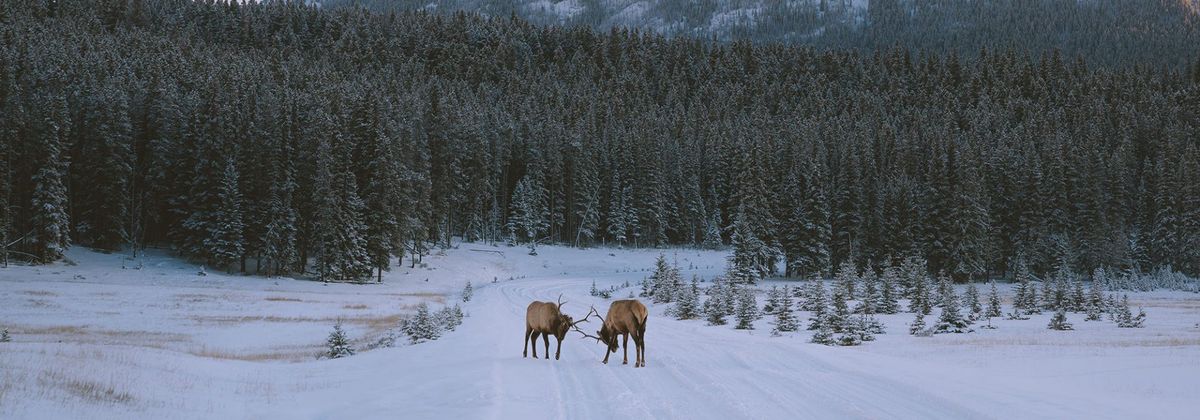
Six Ways to Safely Watch Wildlife in Banff National Park
Viewing wildlife is a bucket-list item on the trips of many to Banff National Park. But to do so responsibly, there are a few things to keep in mind. Following these tips recommended by Parks Canada will help ensure the safety of wildlife for generations to come.
1. Zoom In Your Lens, Not Your Location
Overcrowding and getting too close wildlife puts both yourself and the animal at risk. Using a zoom lens is a great way to see up close details from a safe distance, so if you have one at home it's worth bringing it along on your trip to Banff. No zoom? The animal's habitat is just as beautiful. Avoid approaching the animal for a close-up shot, instead opting for the full picture with stunning Canadian Rockies scenery! Or bring along a pair of binoculars to get a real-time view.
2. Don't Get Stuck in a Jam
Although roadside viewing is one of the most popular ways to watch wildlife, too many vehicles at once can block the road and crowd the animal - a situation referred to as a 'bear jam'. This can cause undue stress on the animal and force them to relocate, using precious energy that they would have otherwise conserved. If they feel cornered or threatened, they may come toward the people observing. Parks Canada advises using roadside pull-offs and parking areas to help avoid traffic congestion around wildlife, rather than pulling over on the road itself. Stay in your car and observe through your window unless the animal is far enough away (more tips on that below!). If there isn't a designated parking area, do not stop - drive by slowly to safely pass the animal, and use your hazards lights to alert other drivers.
INSIDER TIP: Take the 1A aka the Bow Valley Parkway! This highway has a slower speed limit with animal viewing and safety in mind. Cruising along at this 60km/h limit increases your chances of naturally sighting wildlife from your car window. This highway runs adjacent to the Trans-Canada between Banff and Lake Louise and has plentiful sightseeing stops along the way. Be aware this highway is closed for exclusive use by cyclists and pedestrians May-June and September.
3. Keep Your Snacks for Yourself
While it can be enticing to share your trail mix with furry little mountain creatures, this desensitizes them to both humans and their natural diet. Baiting or luring larger animals with food to invite them closer is a huge no-no. Both actions can carry hefty fines, so keep your snacks packed away and enjoy the sights from far away.
The saying goes 'a fed bear is a dead bear' because once they get their first taste of human food, they're very unlikely to return to their natural habits and will always be on the hunt for human food. This increases their encounters with humans and puts everyone at risk. Bears are fed sometimes unintentionally - from garbage not properly disposed of, leftovers from picnics, or dropped snacks. Be cognizant of what you're leaving behind any time you are outdoors.
https://www.instagram.com/p/BpZ2cZRFvbs/?igshid=h3x6qd2n8csr
4. Pack Bear Spray (and Read the Instructions!)
Although winter hangs on at the ski resorts into the warmer months, increased temps in the valley below mean wildlife activity can start surprisingly early - and this includes bears. Don't get caught off guard! Be sure to purchase or rent bear spray, learn how to use it, and bring it along with you on all trails and hikes. We rent bear spray at the SkiBig3 Adventure Hub, located at 114 Banff Ave. if you're only visiting for a few days.
5. Practice Patience and Fine Tune Your Eye
The best way to watch wildlife is often to not go looking for it at all. Slow down your pace and soak in your surroundings, taking in the finer details. Pay attention to the smaller details in nature, like the shift of a tree or an animal track in the snow. These are sure signs that wildlife may be near!
https://www.instagram.com/p/Bu_-Iq5IisY/?igshid=1dc73onogza7a
6. Visit the SkiBig3 Resorts During Summer
Banff Sunshine Village, Lake Louise Ski Resort, and Mt. Norquay all offer summer sightseeing and hiking activities that may provide an opportunity to safely spot wildlife in their natural habitat. When seeing wildlife on any hike, it's important to keep your distance and not alter the animal's behaviour in any way. Generally, bears require 100 metres or 10 bus lengths of distance, while all other large species require 30 metres or 3 bus lengths. Watch out for defensive signals, and leave the area if you cause any change in movement or demeanour.
Wildlife in Banff National Park
Now that you know the ropes, here are just a few species you may be able to see on your next trip to Banff National Park.
- Grizzly Bear
- Bighorn Sheep
- Elk
- Lynx
- Moose
Book a Spring or Summer Trip
Ready to book your spring ski vacation to Banff National Park? Our friendly Reservations Team are always happy to share their local knowledge and experience to help you find the best vacation package for your style and budget. You can reach them by calling 1-844-754-2443.
Other blog posts


Stand-Up Paddleboard in Banff on these 7 Scenic Lakes

Renting a Kayak? 5 Scenic Lakes You Have to Explore

A Guide to Banff’s Best Coffee Spots







